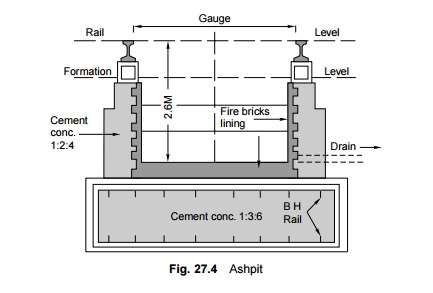Chapter: Civil : Railway Airport Harbour Engineering : Railway Engineering : Equipment at Railway Stations
Ashpits or de-ashing Pits in Railway Stations

Ashpits
Ashpits (also called de-ashing Pits) (Fig. 27.4)
are provided to collect the ashes falling from the locomotives. They are
rectangular in shape and of a depth of about 1 m and are lined with fire
bricks. The length of the ashpits should be adequate so that the longest
locomotive can be de-ashed on the pit. The length is normally 15.9 m (52 ft)
for BG locomotives. The ashpits are suitably sloped from the centre towards the
ends so that water can be drained effectively.

The ashpits should be cleaned as
often as possible. The ashes should first be dumped outside the pit and
subsequently removed and stored at a suitable place for further disposal. The
area around the ashpit should be paved and ample space should be provided for
the picking up and storage of cinder.
Ashpits are normally provided at
those points in the locomotive sheds where the locomotives turn for cleaning or
dropping of fire. These are also provided in big stations at places where the
locomotives collect water for de-ashing.
1.Ash Pans
Ash pans are also used for the
de-ashing of locomotives. These consist of U-shaped precast reinforced concrete
units placed side by side for the retention of ashes. Ash pans are normally
provided in station yards. Though these pans have a very low capacity, they
still have the following advantages.
(a) Easy to
construct
(b) Very
economical
(c) No speed
restriction necessary on the main line when ash pans are provided
2 Examination Pits
Examination pits (also called
outgoing pits) are used both for fire de-ashing before the locomotives leave
the sheds and for outgoing engine examination and repairs. These pits should
have a minimum length of 25 m with stairs at the ends to enable the staff to go
underneath the locomotives for inspection and repair. The pit should be about 1
m deep and lined with fire bricks for about 6 m in the centre where fire
cleaning is to be carried out. A water column should be provided by the side of
each pit.
3 Drop Pits
Drop pits are provided in order
to enable the wheels of the locomotives to be removed for examination, repairs,
and renewals. These pits are normally provided at right angles to the track.
Mobile jacks are installed to enable the wheels and axles to be removed.
Related Topics